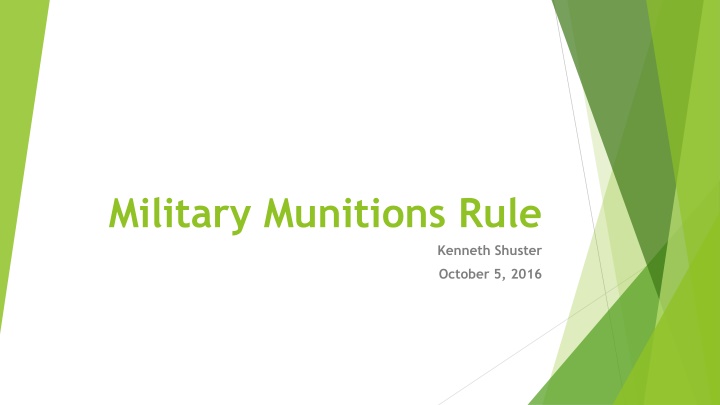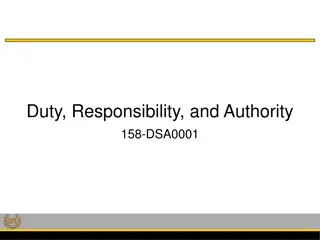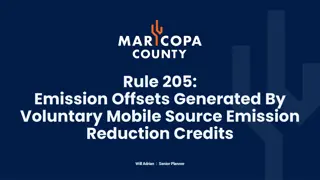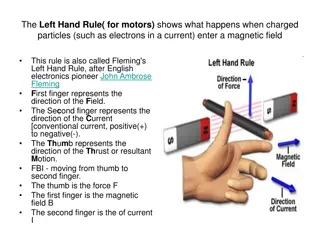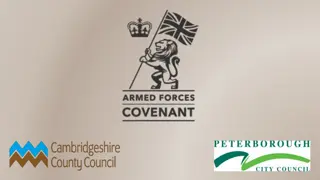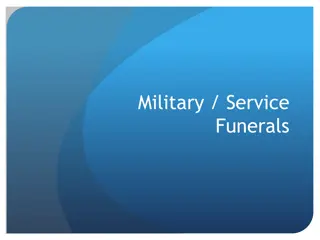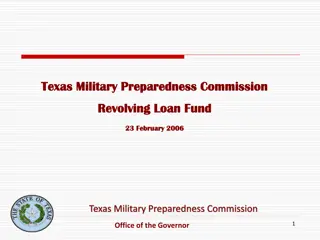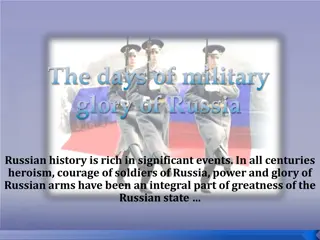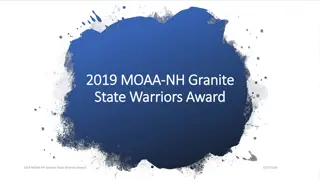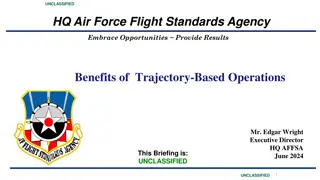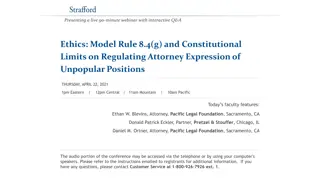History and Implementation of Military Munitions Rule
The history and implementation of the Military Munitions Rule, including its origins in regulations like RCRA and FFCA, the involvement of key stakeholders, identification of issues in rulemaking, and ensuring safe transportation and storage of hazardous waste. The process involved extensive consultations, site visits, rule drafting, and court challenges, resulting in the final rule to protect human health and the environment.
Download Presentation

Please find below an Image/Link to download the presentation.
The content on the website is provided AS IS for your information and personal use only. It may not be sold, licensed, or shared on other websites without obtaining consent from the author.If you encounter any issues during the download, it is possible that the publisher has removed the file from their server.
You are allowed to download the files provided on this website for personal or commercial use, subject to the condition that they are used lawfully. All files are the property of their respective owners.
The content on the website is provided AS IS for your information and personal use only. It may not be sold, licensed, or shared on other websites without obtaining consent from the author.
E N D
Presentation Transcript
Military Munitions Rule Kenneth Shuster October 5, 2016
Presentation Outline History FFCA Issues CT Fishermen s case Regulatory solid waste Statutory solid waste Ranges OB/OD Delay of Closure Emergencies Myths Transportation Storage
History: RCRA 6001 Federal Government shall be subject to, and comply with, all requirements, both substantive and procedural to the same extent, as any person is subject to such requirements The United States hereby expressly waives any immunity to any such substantive or procedural requirement.
History: Federal Facility Compliance Act (1992) FFCA Section 107 added Section 3004(y) to RCRA: (1) EPA shall promulgate regulations, after consulting with DOD and State officials, identifying when military munitions become hazardous waste subject to Subtitle C; and providing for the safe transportation and storage of such waste. Such regulations shall assure protection of human health and the environment. (2) the term military munitions includes chemical and conventional munitions.
History: Chronology (My Involvement) Asked to write the rule: Jan 1992 Met with DOD (4 under-secretaries, DDESB Chairman), formed WG Site visits: Seal Beach; Fallbrook; Edwards; Crane; Ft. Hood, etc. Rewrote existing interim DOD-EPA policy guidance Gathered existing DOD rules and policies Keystone Mil Mun Dialogue, focused on: sustainable munitions, training, ranges Non-stockpile Chemical Weapons WG Documented civilian UXO casualties at FUDS & BRAC Formed Mun Rule WG: EPA, DOD, States, Public (MTP); lots of meetings Proposed Rule: November 8, 1995 [60 FR 56468] Final Rule: February 12, 1997 [62 FR 6622] Administrative Record; RtC Document Survived court challenge (MTP)
History: RCRA issues identified in rulemaking process Unused munitions demil stockpiles: when do they become a waste (& storage regs kick in) When damaged? When obsolete? When treaty says to destroy? Military mission is paramount Safety first, then public health & environment Training in burning propellant: is this RCRA treatment? Active Ranges: results in depositions/discharges - require RCRA permits? Closed Ranges OB/OD; BIP when are permits required? When are alternatives required? Emergencies Transportation Storage
History - Landmark Case: Statutory v. Regulatory Solid Waste & Hazardous Waste Connecticut Coastal Fishermen s Assoc. v. Remington Arms, et al, 2ndCircuit Court of Appeals (1993) [EPA amicus brief, Aug. 31, 1992]: Critical is the meaning of the terms solid waste and hazardous waste Defining what Congress intended by these words is not child s play, even though RCRA has an Alice in Wonderland air about it. We say that because solid waste plainly means one thing in one part of RCRA and something entirely different in another part of the same statute. When I use a word, Humpty Dumpty said in a rather scornful tone, it means just what I choose it to mean neither more nor less. The question is, said Alice, whether you can make words mean so many different things. The question is, said Humpty Dumpty, which is to be master that s all.
Statutory v Regulatory Solid Waste Statutory solid waste is broader Discarded material left to accumulate long after they have served their intended purpose 2nd circuit opines: without deciding how long materials must accumulate before the become discarded that is, when the shot is fired or at some later time we agree that the lead shot in Long Island Sound have accumulated long enough to be considered solid waste. AMC I case: once product is indisputably discarded, it has become part of waste disposal problem and may be regulated under RCRA AMC II case: same; deferring to the EPA s focus on potential environmental harm in determining whether material is discarded. Regulatory solid waste is narrower Discarded material that been abandoned or disposed of
Regulatory & Statutory Corrective Action Authorities RCRA 3004(u); 40 CFR 264.101: SWMUs releases RCRA 3004(v); 40 CFR 264.101: releases beyond fac boundary RCRA 3005(c)(3); 40 CFR 270.32(B)(2): any conditions to protect HH&E RCRA 3007: info gathering & inspections, incl. sampling RCRA 3008(a): compliance orders RCRA 3008(h): interim status corrective action orders RCRA 3013: monitoring, analysis, & testing orders RCRA 7003/CERCLA 106/SDWA: imminent & substantial endangerment orders
Myths Just declare a situation involving explosives is an emergency and RCRA doesn t apply. Explosives in an emergency situation are not a waste. If you OB/OD explosives on an active range, RCRA doesn t apply. So long as a fired munition or its contaminants are on a range/former range, RCRA doesn t apply. OB/OD is the cheapest explosives treatment method. OB/OD is a clean technology: all the explosives are consumed in the fireball.
History: OB/OD All OB/OD of HW is prohibited, except for explosives (May 18, 1980) Part 265: only when no alternatives; 1980 Part 264: Subp X (performance stds); 1986(?) OB/OD is treatment, not disposal Challenged in Court EPA prevailed Therefore: LDRs do not apply Must clean close
OB/OD Contamination Data Notes: These are the worst cases identified to date. Red numbers are the number of times the concentrations in soil or ground water exceed EPA action levels [action levels used are in brackets after each contaminant]. This data was compiled by two summer interns (Jordan 2014, and Michelle 2015) from RCRA and CERCLA data. The intern names on the cost table indicate how much the costs increased from 2014 to 2015, costs in red is the difference.
OB/OD Contaminant Data Soils RDX [5.6 mg/kg EPA residual screening level] Chemtronics, Inc. 290 mg/kg 52X Camp Minden (LA AAP) 100mg/kg explosives TNT [19 mg/kg EPA resid screening level] Umatilla Army Depot, OR 36,045 mg/kg 1897X Chemtronics, Inc. 280 mg/kg Perchlorate [15 g/L] Redstone Arsenal (Army/NASA) 106,000 g/kg 7067X Worst concentrations tend to be close in and further out 13
OB/OD Contaminant Data (cont.) Groundwater RDX [2 g/L] Bangor Ordnance Disposal (Navy) 10,000 g/L 5,000X Nebraska Ordnance Plant 534 g/L Mass Military Reservation 370 g/L, 7300 ft plume Dahlgren Naval Warfare Center 127 g/L Redstone Arsenal (Army/NASA) 96 g/L TNT [2 g/L] Banger Ordnance Disposal (Navy) 40 g/L (stormwater) 20X Nebraska Ordnance Plant 39 g/L Perchlorate [15 g/L] Mass Military Reservation 500 g/L, 10,000 ft plume 33X 14
OB/OD Cleanup Costs 3 contamination zones: Unit (incl particulate fallout area) Kick-out area Ground water plume Cleanup costs: Plattsburgh Air Force Base $8.9m (rounded) Banger Ordnance Disposal Chemtronics, Inc. 8.2m Aqua Tech Environmental Inc. (Groce Labs) $4.7m Picatinny Arsenal, NJ Cecil Field USN Air Station US Army/NASA Redstone Arsenal $1.7m Moffett Naval Air Station, CO Bangor Naval Submarine Base Lawrence Livermore Natl Lab (DOE) $447m $626.7m (Michelle) $180m (Jordan) $110m (Jordan) $82m $192m (Michelle) $6.2- $8.9m Ft. Wingate, NM Air Force Real Property Agency/ Castle Air Force Base >$150m $3.9m $2.8m Nebraska Ordnance Plant $61m $16m (Jordan) $32m Idaho Natl Engg Lab (DOE) $48.3m (Michelle Iowa Army Ammunition Plant $40.3m $1.1m $.9m US Army Garrison/Ft. Wainwright $10.9m 15 Umatilla Army Depot, OR >$10m
Regulatory solid waste Products are not solid wastes if they are applied to the land when used and that is their ordinary manner of use. That is, RCRA regs do not apply; Statutory authorities may apply.
A Military Munition is NOT a Solid Waste When: [Section 266.202(a)] Used for it s intended purpose: 1) In training (including safe destruction) In research, testing On-range destruction of UXO or frag during range clearance at active or inactive ranges (i.e., OB/OD) Does not include: On-range disposal/burial (i.e., when deposition is not a result of product use) On-range OB/OD of off-range explosives
A Military Munition is NOT a Solid Waste When: 2) Unused munition is repaired, reused, recycled, reclaimed, disassembled, reconfigured, etc, unless involve use constituting disposal or burning for energy recovery.
Delay of Closure Concept borrowed from pvt sector petition for surface impoundments to continue to receive non-haz wastes As applied to DOD, applies to RCRA-permitted OB/OD units that: Continue to treat only RCRA-exempt wastes: On-range treatment of range clearance materials Training Emergencies Closed units on an active range that continues to generate the same contaminants.
Emergencies Exemption from RCRA for immediate responses Only for true emergencies: immediate responses Only very short delays allowed, e.g., due to weather, mobilization time (generally hrs or days, not weeks or months) If involves military munitions, the responding unit must retain records for 3 yrs identifying dates, persons, type & description of material addressed, and its disposition [40 CFR 270.1(c),(3)(iii)] Important to record if munition had been fired (used, UXO) or not Otherwise, emergency permit [40 CFR 270.62] Only good for 90 days; not renewable Otherwise, full permit
Transportation & Storage Conditionally Exempt: From RCRA manifest, if transport from DOD to DOD by DOD bill of lading From RCRA storage permit, if stored according to DDESB standards Or RCRA storage permit
Qualifiers Mil Mun Rule mostly clarified existing rules/policies More stringent in 2 respects: DOD to retrieve munitions landing off-range or keep a record of the event [266.202(d)] For immediate emergency responses involving mil mun, must keeps records [40 CFR 270.1(c),(3)(iii)] Less stringent in 2 respects: Conditional exemption from manifest Conditional exemption for storage States can be more stringent E.g., Must notify State before any emergency responses UT; MA Adoption status: Fed imple (2) or State adopted as is 34 State adopted with changes 10 Not adopted - 9 RCRA applies to all DOD activities in U.S. and territories RCRA not applicable to overseas activities nor operations aboard ship
Myths Just declare a situation involving explosives is an emergency and RCRA doesn t apply. Only in true emergencies Explosives in an emergency situation are not a waste. They are a waste, just exempt from regs under certain conditions If you OB/OD explosives on an active range, RCRA doesn t apply. Only if the wastes originated on-range So long as a fired munition or its contaminants sit on a range/former range, RCRA doesn t apply. Regulatorily true; Statutorily not true OB/OD is a clean technology: all the explosives are consumed in the fireball. Extensive kickout, soil & GW contamination OB/OD is the cheapest explosives treatment method. When considering full cost of clean-up/closure, is far more expensive
History: Chronology (My Involvement post MMR, cont.) EPA-DOD Munitions Principals: March 7, 2001 Digital geo-referenced technologies to replace mag & flag Led effort to replace explosive spot charges with non-explosives: Oct 2015 FUDS Universe Site-specific work: Mass. Military Reservation (active training range shut down by EPA, lead) On apex of recharge zone of SDWA-designated sole source aquifer Donovan Chamber
My Contact Information: Shuster.Kenneth@epa.gov 703-308-8759
Maybe slide More Site-Specific Examples American University Experimental Center, Spring Valley, Wash, DC Arsenic; Lewisite; Mustard gas; Arsine gas; Phosgene; Chloropicrin Brandt dirt AU Child Development Center David Oates Camp Croft, SC Camp Minden, LA Radford AAP , VA Ft. Wainwright, AK Sea Disposal Data base Incidents A better way
